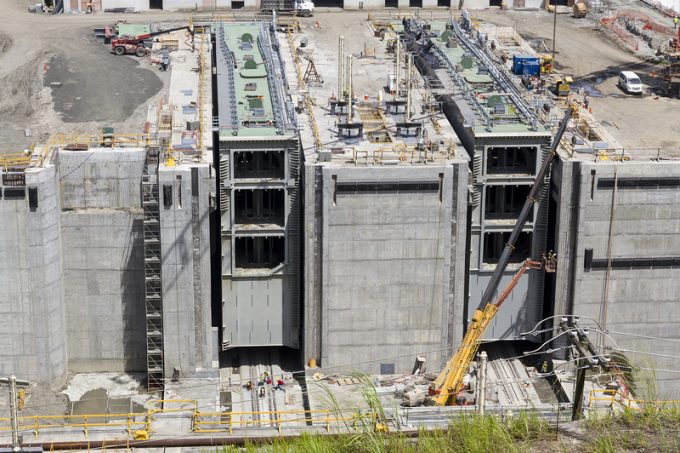CMA CGM purchases chartered Seatrade feeder quintet
French carrier CMA CGM has acquired all five of the 2,300 teu feeder ships it ...
GM: RAISING THE ROOF GGM: IN FULL THROTTLE GZIM: MAERSK BOOST KNIN: READ-ACROSSMAERSK: NOT ENOUGHMAERSK: GUIDANCE UPGRADEZIM: ROLLERCOASTERCAT: HEAVY DUTYMAERSK: CATCHING UP PG: DESTOCKING PATTERNSPG: HEALTH CHECKWTC: THE FALLGXO: DEFENSIVE FWRD: RALLYING ON TAKEOVER TALKODFL: STEADY YIELDVW: NEW MODEL NEEDEDWTC: TAKING PROFIT
GM: RAISING THE ROOF GGM: IN FULL THROTTLE GZIM: MAERSK BOOST KNIN: READ-ACROSSMAERSK: NOT ENOUGHMAERSK: GUIDANCE UPGRADEZIM: ROLLERCOASTERCAT: HEAVY DUTYMAERSK: CATCHING UP PG: DESTOCKING PATTERNSPG: HEALTH CHECKWTC: THE FALLGXO: DEFENSIVE FWRD: RALLYING ON TAKEOVER TALKODFL: STEADY YIELDVW: NEW MODEL NEEDEDWTC: TAKING PROFIT

After nine years of construction, 130m tonnes of excavated spoil and 4.4m cu metres of concrete, the Panama Canal’s third set of locks will be inaugurated in June – barring any further delays.
The mammoth US$5bn project expects to see the average capacity of containerships transiting the canal nearly triple, from 5,000 teu to 14,000 teu, ushering in a new post-panamax era for container shipping.
Industry debate on how the expansion will affect container supply chains largely centres on whether US east coast (USEC) ports can capture significant cargo volumes from their west coast counterparts.
After June, shipping lines will have the option to re-route mega-ships with Asia-USEC bound cargo via the Panama Canal. Multiple variables are at play, including the handling capabilities of USEC ports; the canal’s new toll structure; and competition with the Suez Canal.
Meanwhile, less attention has been paid to any potential impacts on regional reefer trades, and whether perishables shippers can expect the expansion to affect their transportation options.
“Long term, it’s likely that more carriers will use the Panama Canal region as a transhipment hub,” said Gary York, director of global sourcing at Robinson Fresh, the fresh produce brand of global 3PL CH Robinson.
He added: “Instead of sending a ship from Chile to multiple ports on the US east coast, these feeder vessels will discharge in Panama to larger post-panamax vessels that will then be able to carry containers from multiple origins, including Latin America.
“The same is true for Asia or European destinations, with containers from the Latin America region arriving in the Panama region on smaller vessels and transhipping to the much larger ships destined for Europe or Asia.”
Research conducted last year by CH Robinson and Boston Consulting Group on the trade impacts of the canal expansion found that up to 10% of container traffic to the US from East Asia could shift from west to east coast ports by 2020, adding that increased use of transhipment in the Caribbean could magnify this trend.
Caribbean ports will be hopeful of an upturn in transhipment cargo. Panama, in particular, is positioning itself as a regional transhipment and value-added logistics hub.
According to Drewry, Panama transhipment activity could jump by double digits following the canal expansion, with annual growth of 5% a year thereafter. At the canal’s Pacific end, a new 5m teu container terminal will be built at Corozal to capitalise on the expected increase in transhipment traffic.
It remains to be seen whether the economies of scale gained from deploying larger vessels, and the resulting increase in transhipment will translate to lower reefer rates for perishable shippers. And while Panama could be a big beneficiary by operating as a regional hub for cold chain logistics services, some shippers will undoubtedly be concerned by longer transit times and the added handling risks associated with transhipment.
From the perspective of US shippers, Mr York pointed out that there could be long-term effects as the market reacts to the additional supply chain options.
“First, shippers and importers from the middle and eastern regions of the US will have expanded shipping options versus solely utilising the west coast ports. However, many of the effects from the Panama Canal expansion will be felt in the years to come, as supply chains react to the changes taking place in the market.
“If supply of ocean container services is increased by the expansion on the east and Gulf coasts, this could potentially translate to reduced prices. In addition, the investment and routing decisions of rail and truck carriers, and the location of distribution centres, are likely to change, based on trade-offs that shippers make between the cost and speed of transportation,” he said.
Comment on this article